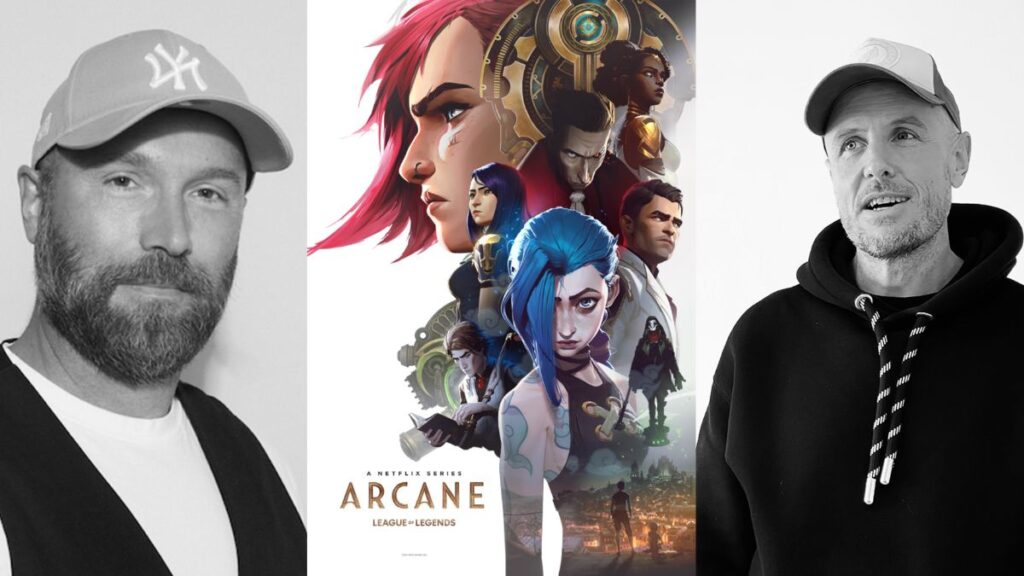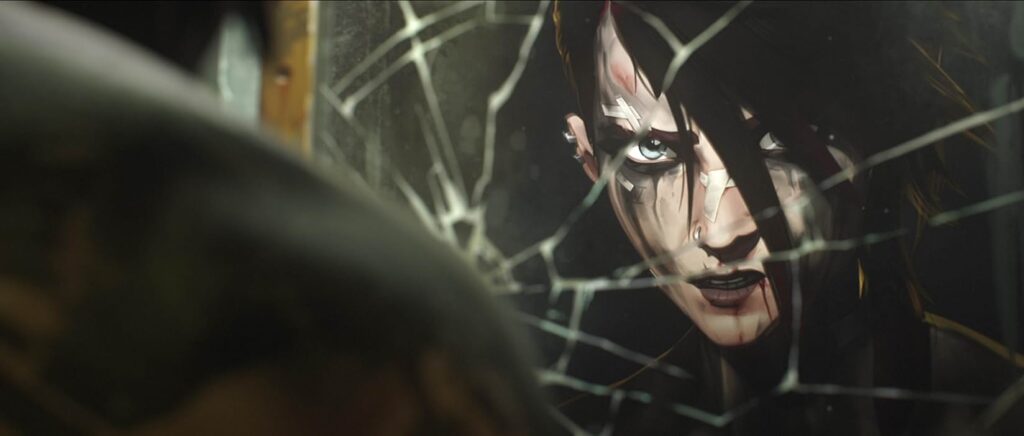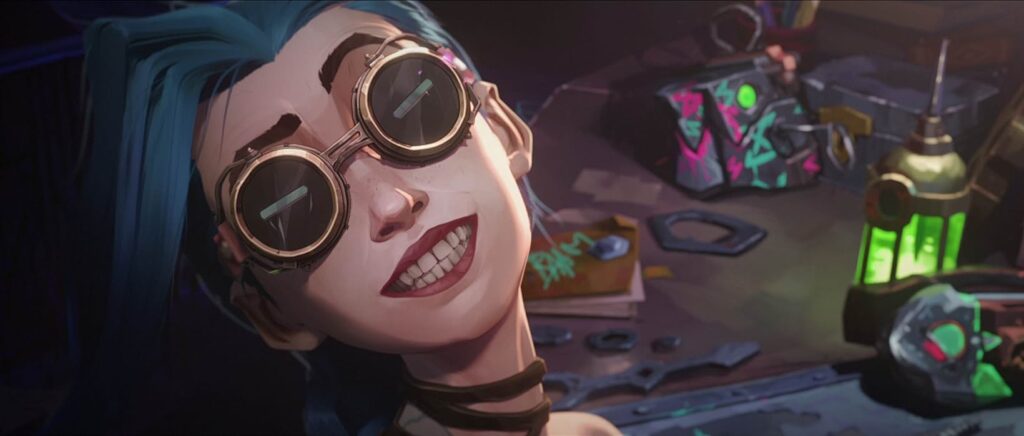
Few video game adaptations have garnered the acclaim and cultural impact of Arcane. Set in Riot Games’ expansive League of Legends universe, Arcane explores the compelling and turbulent relationship between sisters Vi and Jinx. Since its release in 2021, the series has garnered widespread acclaim for its groundbreaking animation, rich storytelling, immersive world-building, and emotional depth. It has managed to appeal to both newcomers unfamiliar with League of Legends and dedicated fans of the game.
The series, brought to life by the innovative French animation studio Fortiche Productions in collaboration with Riot Games and distributed by Netflix, quickly rose to global popularity, claiming the top spot on Netflix’s Top 10 chart in 52 countries and reaching second in the USA. With season two now releasing, Arcane continues to build on the success and impact that Fortiche has had in pushing the boundaries of animated storytelling.
Fortiche Productions has evolved remarkably from its roots in music videos and commercials to being one of the industry’s most acclaimed animation studios. Arcane exemplifies this journey, setting new benchmarks in seamlessly integrating 2D and 3D animation and delivering nuanced character-driven narratives.
At this year’s VIEW Conference, AnimationXpress had the pleasure of speaking with Pascal Charrue, co-founder of Fortiche Productions and co-director of Arcane, along with Alexis Wanneroy, the studio’s character animation supervisor. They shared insights into the studio’s growth, their creative process on Arcane, and their aspirations for the future.
Fortiche has transitioned from producing commercials and music videos to becoming a globally acclaimed animation studio, known for animated series. To what do you attribute the studio’s success?
Pascal: Our journey at Fortiche Production has been a true team effort, built on a foundation of shared tastes in music, movies, and other creative outlets. Each of us brought a unique skill set—some with a background in music, others in comics, and various artistic domains. This blend of complementary talents was essential in shaping the studio’s creative identity from the start.
In the beginning, we were a small, close-knit team with the flexibility to experiment and refine our process. We worked on music videos initially, which gave us the freedom to test out ideas and find our distinctive style. This format, being so expressive, was perfect for discovering what we now call the “DNA of Fortiche’s visuals.”
As we grew, we focused on bringing in highly skilled animators and exceptional concept artists. The “secret sauce” to our success lies in combining a clear artistic vision with the right talent and then guiding that talent to innovate. Fortiche’s success is ultimately the result of this collaborative approach, where every team member’s expertise contributes to pushing our creative boundaries forward.
Fortiche’s signature graphic style blends 2D and 3D media in a unique way. Where did your love for this style originate, and how has it evolved over time?
Pascal: When we started searching for our original style, it was about finding something unique that would visually set us apart, both in storytelling and in aesthetics. There are so many talented studios in Paris, particularly in 3D animation, and we didn’t want to compete directly with them. Instead, we wanted to carve out a style that would resonate on screens for young and adult audiences alike.
The project Arcane provided the ideal opportunity to gain international recognition with a style and tone that felt authentically ours. We wanted something that would make people immediately recognise it as Fortiche, and Arcane allowed us to refine and showcase that style on a global platform.
Alexis: Additionally, the founders of Fortiche, like Pascal and Arnoud Delord, have a profound love for art, illustration, and comic books. This passion has driven them to create a visual experience that feels deeply artistic, rather than just technically impressive. For them, it’s about expressing a unique artistic vision on screen.
Adapting a popular game into an animated series is already a challenging feat, which you achieved brilliantly in season one. The response was phenomenal. With season two on the horizon, did you feel any additional pressure to surpass your previous work?
Pascal: Yes, of course, there was pressure. We had a lot of success with season one, including multiple Emmy and Annie awards, so there was an expectation for season two to live up to that. When you have a successful first season, there’s always that fear that the second season might not meet expectations. We’ve seen that happen in other franchises—where a great movie has a follow-up that doesn’t quite hit the mark.
For us, the focus was on ensuring that the visual quality was not only maintained but improved upon. The pressure was definitely there, but what kept us motivated was the support from the fans. Some even said, “Take all the time you need.” Reading those messages was heartwarming, so thank you, fans. There’s definitely a lot of expectation, but across all departments, the team has really stepped up to make season two as exceptional as possible.
One of the standout elements of Arcane is the emotional depth of the characters. How did you ensure that these emotions are communicated effectively through animation?
Alexis: We rely heavily on references. We film ourselves repeatedly until we capture the right moment. It’s a meticulous process, and we aim to act in a natural, genuine way rather than exaggerating the emotions. Often, references in animation involve principles like anticipation or accents, but for Arcane, we wanted to think more like actors. We asked ourselves, “Who is this character? How would the actor play this moment?” and really immersed ourselves in it.
When we look at the reference footage, sometimes we’re deeply moved — we cry for real. When you’re working on a scene for a week, emotionally investing in it, you feel the sadness and the weight of it. We wanted to make sure that those feelings came through in the animation, which meant we had to live those emotions ourselves during the process. It’s challenging, but it’s essential to convey those real emotions on screen.

Can you give us any insights into your production pipeline for Arcane? How extensive is the storyboarding process before the animation moves into production?
Pascal: For us, it’s really important to lock things down early in the process—not too early, but we spend a lot of time on storyboarding. The goal is to ensure that once we start, all the steps afterward are streamlined, and we don’t have to redo or rework things constantly. We invest a significant amount of time in pre-production, mood boards, and storyboards to develop the sequences. This gives all the departments a clear direction, ensuring that what they work on will be kept and not changed down the line.
This approach involves a lot of time, effort, and artistry, and, admittedly, it can be challenging for our artists—sometimes months of their work might not make it to the final cut. But it’s essential because by nailing down these early stages, we can focus on pushing the artistry in each shot, knowing that it’s set and won’t need reworking. I’d say that Fortiche’s DNA is deeply embedded in this process.
Alexis, you’ve worked on major projects like How to Train Your Dragon, and Kung Fu Panda, each with its distinct style. How did you adapt to Arcane‘s unique animation style?
Alexis: When I arrived at Fortiche Productions, I had already worked on projects like Rise of the Guardians and How to Train Your Dragon 3. Those projects had a sensibility that I connected with — more mature, emotional stories like The Prince of Egypt. That’s always been my style preference, something deeper and more dramatic, rather than cartoony.
At Fortiche, I could finally push that further, exploring adult themes and real subtext. Working on emotional drama and complex character emotions in Arcane has been a dream come true for me, allowing me to fully dive into a style that’s both visually and emotionally mature.
The music in the trailer adds a powerful tempo to the visuals. How important is music for the overall feel of Arcane, and what’s your take on its role?
Pascal: Music is core part of our studio’s DNA. When we were working on the first season of Arcane, we hadn’t planned for a musical moment in every episode, but we soon realised how powerful it could be in elevating the directing, adding dynamism to the montage, and deepening the storytelling. Christian Linke, the showrunner, was also behind the music in the original Riot Games soundtracks, so there was already a strong connection to the music world.
In season one, we collaborated with big names like Imagine Dragons, and we wanted to continue that for season two. Having well-known artists not only enhances the story but also supports promotion — it’s amazing for the team and resonates with audiences. This approach, which we call “clip-esque,” comes from our roots in music videos, where each episode has a sequence that feels like a music video. It brings a unique energy, almost like a “music video moment,” which has been part of our style from the start.
For example, our first trailer with Riot was initially just meant to be a trailer, but we saw the potential for it to become more of a music video. At that time, trailers didn’t often take that approach, so it gave us a distinct edge. It was a unique strategy, and it worked really well for us.
The success of Arcane has been phenomenal both critically and commercially. What do you think resonated most with audiences globally? And were you surprised by the reaction to the show?
Pascal: To be honest, the success was huge, and yes, I was surprised — but I also tried to remain consistent and stay focused on the process. This project was very original, and there’s always risk involved when doing something that hasn’t been done before. Before Arcane was released, I met a lot of people who were genuinely excited about it, and that gave me confidence.
Knowing the massive following of League of Legends — with around 150 to 180 million players — added to my confidence that Arcane would reach a huge audience. Plus, when you release something like a music video, and you see thousands of people watching it in seconds, it’s incredibly impressive.
What innovative tools or techniques did you use during the production of Arcane’s second season?
Pascal: To be honest, we didn’t use any groundbreaking new tools. We have a solid team of script developers and people dedicated to finding ways to make everyone’s job easier. The techniques we used back in 2009 are largely the same today in 2024. Compositing and visuals are key, but what we focus on is making the process efficient. The only difference is that now we can render faster and react more quickly, which allows us to make adjustments until the work is exactly how we want it.
Alexis: In terms of technology, the way we build characters and rigs for animation is amazing. For instance, the rigs are real-time, meaning when I press play in Maya, it runs without needing pre-render playback. This saves a lot of time and allows us to focus on fine details. We also utilise matte painting extensively, which reduces the need to model each asset individually. So, while we’re not necessarily using the latest high-tech tools, we’ve found smart ways to work with the tools we have, allowing us to push creative boundaries.

How has the success of Arcane shaped your vision for future projects? Do you see this as a turning point for animated series aimed at a more mature audience?
Pascal: For us, our main goal has always been to create animation for young adults. In the beginning, it wasn’t easy to find success with this approach, but with Arcane, things changed. Our hope is to reach a point where animation, like in Japan, is widely appreciated without any stigma around it. Whether it’s in France or globally, people should feel comfortable watching animation regardless of their age. At first, when we started working on Arcane, friends would say, “Oh, you’re working on something for a video game”, but I always emphasised that it was a show.
Now, when people talk to us, they say they saw our TV show, and even at the Cannes Festival, the festival director mentioned it as a TV show. This recognition shows how much the perception of animated content is evolving. Everyone keeps telling us that we’ve redefined what’s possible in this space, and they hope we keep going further. Right now, there’s not much happening in adult animation, and we want to continue exploring new ways to elevate this genre.
Alexis: What’s amazing is that Arcane’s success has inspired producers and major players in the industry to invest in more adult shows. It’s not only about studios wanting to create these projects; it’s about having producers and platforms like Riot Games and Netflix, who believe in the potential of adult animation.
What advice would you give to aspiring animators or directors who want to start their own studio and pursue a career with their unique style?
Pascal: I’d say, focus on originality. Talent is important, of course, but passion and dedication are what really make magic happen. When we started out, we were in a small apartment, working nights to test out different things. You have to be ready to put in that time and effort. I remember when I was a student, I’d come back from parties and still work on my craft because I was so committed to making something of myself.
You learn more by doing, and both good and bad experiences can be valuable. In fact, sometimes the bad experiences teach you more than the good ones. I’ve been through challenges working with different companies, and if you’re passionate and committed, you can reap great results. Surround yourself with talented people, work hard, and keep pushing toward the vision you have in mind.

